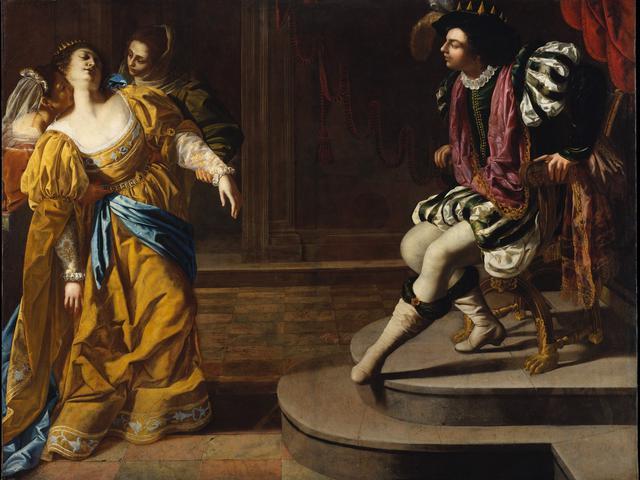Esther and Ahasuerus

The Persian king Ahasuerus attempted to exterminate all the Jews in his land. Esther wants to ask the king to forgive the Jews. But it was forbidden to approach the king without being asked, so Esther was very scared. When she stands before the angry king, she faints.
Then the king becomes kind and tries to reassure her by saying that the decree only applies to common people. The biblical theme does not serve as a theme for a religious painting, but as a pretext for a variation of the oriental odalisque. Esther is a woman from the east, one of those creatures, all curves and arabesques, imagined by Ingres, whose student was Chasseriau. And, indeed, the image, which exudes sensuality and love for fluid feminine contours, is reminiscent of Ingres and his odalisques. However, if Esther is represented as an oriental, this is not the case with the sky, the background or the two figures flanking her. The fabrics, jewels and chromatic harmony that enhance Esther's dazzling body bear witness to Chassériau's admiration for Delacroix.
Artemisia Gentileschi (born July 8, 1593, Rome, Papal States; died 1652/53, Naples, Kingdom of Naples), Italian painter, daughter of Orazio Gentileschi, who was a great follower of the revolutionary Baroque painter Caravaggio. She was an important defender of the second generation of Caravaggio's dramatic realism.
A student of his father and his friend the landscape painter Agostino Tassi, he initially painted in a style indistinguishable from his father's somewhat lyrical interpretation of Caravaggio's example. His first known work is Susanna and the Elders (1610), a completed work attributed to his father. He also painted two versions of a scene already rehearsed by Caravaggio (but never attempted by his father), Judith Beheading Holofernes (c. 1612-13; c. 1620). She was raped by Tassi and, when he did not keep his promise to marry her, Orazio Gentileschi in 1612 put him on trial. During that event, she herself was forced to testify under torture.
© Tourblink